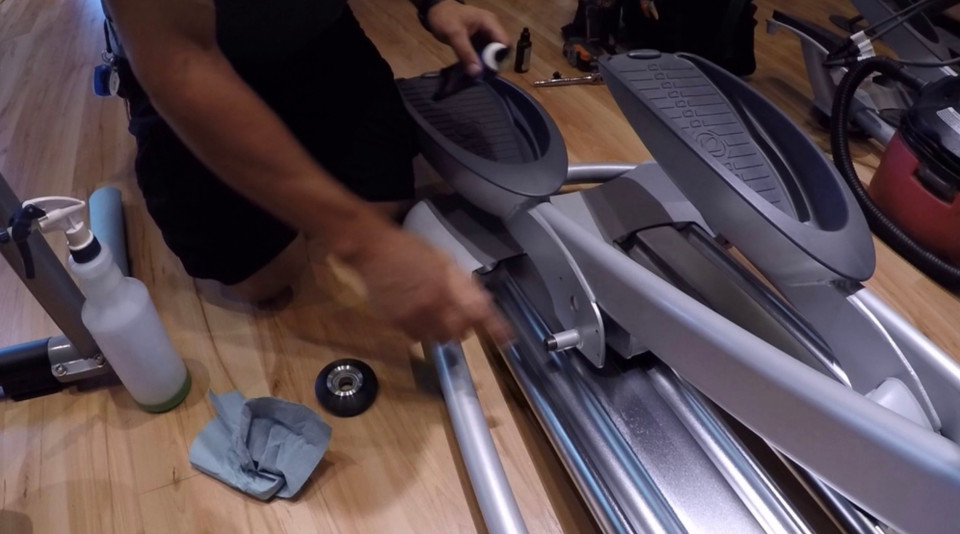Introduction to Elliptical Bike Maintenance and Repair
Elliptical bikes are a popular choice for fitness enthusiasts due to their ability to provide a low-impact cardiovascular workout. However, just like any other fitness equipment, they require regular maintenance and repair to function optimally. Understanding the importance of elliptical bike maintenance and repair is crucial for extending the lifespan of your equipment and ensuring a safe workout environment.
Regular maintenance not only enhances the performance of the elliptical bike but also helps in identifying potential issues before they escalate into major problems. By adopting a proactive approach to maintenance, users can save on costly repairs and avoid unnecessary downtime. This guide aims to provide a comprehensive overview of the essential aspects of elliptical bike maintenance and repair.
In this article, readers will explore the various components of an elliptical bike, common issues requiring repair, and preventive maintenance tips. Additionally, the article will differentiate between DIY and professional repair approaches, outline necessary tools, and offer best practices to keep your elliptical bike in top shape.
Understanding the Components of an Elliptical Bike
Elliptical bikes are composed of several intricate components, each playing a vital role in its operation. Familiarity with these parts can aid in effective maintenance and timely repairs. Key components include the drive system, resistance mechanism, and electronic display, among others.
-
Drive System: This includes the flywheel, pedals, and linkage arms, which work together to create the smooth, elliptical motion associated with these machines. The drive system is the heart of the elliptical bike, and any malfunctions here can significantly affect usability.
-
Resistance Mechanism: This feature allows users to adjust the intensity of their workout. It typically involves magnetic or friction-based resistance systems, both of which require regular checks to ensure they are functioning correctly.
-
Electronic Display: The console provides essential workout data such as time, speed, distance, and calories burned. It's crucial for maintaining motivation and tracking progress, making it important to keep this component in good working order.
Understanding these components allows users to perform effective maintenance and recognize when repairs are necessary. By becoming familiar with the internal workings of the elliptical bike, users can better appreciate the importance of regular upkeep.
Why Regular Maintenance is Crucial
Regular maintenance of elliptical bikes is essential for several reasons. First and foremost, it ensures the safety of the user. Faulty equipment can lead to accidents and injuries, which are preventable with proper care and attention. By maintaining the equipment, users can work out with peace of mind, knowing that the risk of malfunctions is minimized.
Moreover, regular maintenance enhances the performance and efficiency of the elliptical bike. A well-maintained machine provides a smoother, more enjoyable workout experience, encouraging consistent use. This can have a direct impact on the user's fitness journey, enabling them to achieve their health goals more effectively.
Finally, investing time in maintenance can lead to significant cost savings. By identifying and addressing small issues early on, users can avoid expensive repairs down the line. Routine checks and upkeep not only protect the machine but also ensure that it remains a worthwhile investment for years to come.
Common Issues Requiring Elliptical Bike Repair
Despite regular maintenance, elliptical bikes may encounter issues that necessitate repair. Understanding these common problems can help users troubleshoot effectively and determine when professional intervention is required. Some prevalent issues include:
-
Unusual Noise: Squeaking or grinding sounds often indicate a problem with the drive system, such as worn-out bearings or a misaligned belt. Addressing these noises early can prevent further damage.
-
Resistance Malfunctions: If the resistance levels are not adjusting correctly, it may suggest a problem with the resistance mechanism. This could be due to a faulty motor or a broken magnetic resistance system.
-
Console Errors: Problems with the electronic display, such as blank screens or inaccurate readings, may result from loose connections or software glitches. Regular maintenance can help identify these issues before they worsen.
Understanding these common problems can aid users in performing basic troubleshooting. However, for more complex issues, seeking professional repair services ensures that the elliptical bike is restored to optimal condition.
Preventive Maintenance Tips for Your Elliptical Bike
Preventive maintenance plays a vital role in extending the life of an elliptical bike. By adhering to a routine maintenance schedule, users can avoid many common issues and ensure their equipment remains in peak condition. Here are some key tips to consider:
-
Regular Cleaning: Dust and sweat can accumulate on the bike, leading to corrosion and mechanical issues. Wiping down the machine after each use and performing a deeper clean weekly can prevent these problems.
-
Lubrication: Keeping moving parts well-lubricated reduces friction and wear. Applying lubricant to the joints and drive system components every few months is recommended.
-
Inspection: Regularly inspect the machine for loose bolts, cracks, or other signs of wear. Tightening connections and replacing worn parts promptly can prevent further damage.
By integrating these preventive measures into their routine, users can significantly enhance the performance and longevity of their elliptical bike. Consistent maintenance is the key to a smooth and effective workout experience.
Step-by-Step Elliptical Bike Maintenance Guide
Performing maintenance on an elliptical bike can seem daunting, but breaking it down into a step-by-step process simplifies the task. Here is a comprehensive guide to maintaining your elliptical bike effectively:
Step 1: Cleaning
- Materials Needed: Soft cloth, mild detergent, water.
- Process: Wipe down all surfaces of the bike, paying special attention to areas prone to sweat accumulation. Avoid using harsh chemicals that could damage the machine.
Step 2: Inspection
- Focus Areas: Bolts, pedals, drive system, and electronic display.
- Process: Check for loose bolts, cracks, or other signs of wear and tear. Ensure that all components are securely fastened.
Step 3: Lubrication
- Materials Needed: Approved lubricant.
- Process: Apply lubricant to the pedals, joints, and any moving parts. Be cautious not to over-lubricate, as excess can attract dust and debris.
Step 4: Testing
- Objective: Ensure all components function correctly.
- Process: Power on the machine and test all settings, including resistance levels and electronic display functions. Address any anomalies immediately.
By following this guide, users can perform thorough maintenance on their elliptical bike, ensuring it remains in excellent condition for continued use.
DIY vs. Professional Elliptical Bike Repair
When faced with repair needs, users often grapple with the decision between DIY repairs and hiring a professional. Each approach has its advantages and limitations, and the choice depends on the complexity of the issue and the user's technical expertise.
DIY Repair
- Pros: Cost-effective, immediate action, and a learning experience.
- Cons: Risk of incorrect repairs leading to more significant damage, voided warranties if not done correctly.
Professional Repair
- Pros: Expertise and experience, guarantees quality workmanship, and access to specialized tools.
- Cons: Higher costs, potential wait times for appointments.
For minor issues and routine maintenance, DIY repairs can be effective. However, for complex problems or when in doubt, seeking professional assistance ensures that the elliptical bike is repaired correctly and efficiently.
Tools and Supplies Needed for Elliptical Bike Maintenance
Maintaining an elliptical bike requires specific tools and supplies to ensure effective upkeep. Having these items on hand can streamline the maintenance process and facilitate timely repairs. Essential tools and supplies include:
- Basic Tool Kit: Wrenches, screwdrivers, and pliers for tightening bolts and making minor adjustments.
- Lubricant: High-quality lubricant specifically designed for fitness equipment to reduce friction and wear.
- Cleaning Supplies: Soft cloths, mild detergent, and water for regular cleaning and prevention of corrosion.
- Replacement Parts: Commonly worn components such as pedals, belts, and bearings can be kept in stock for quick replacements.
By equipping themselves with the necessary tools and supplies, users can maintain their elliptical bike efficiently and address issues promptly, minimizing downtime.
Best Practices for Keeping Your Elliptical Bike in Top Shape
To keep an elliptical bike in top shape, users should adopt a set of best practices that go beyond regular maintenance. These habits ensure that the machine remains functional and reliable over the long term.
-
Follow Manufacturer's Guidelines: Adhering to the maintenance schedule and recommendations provided by the manufacturer ensures that the machine is cared for correctly.
-
Environment Considerations: Position the elliptical bike in a clean, dry area to prevent moisture damage and dust accumulation.
-
User Habits: Encourage users to wear appropriate footwear and avoid excessive force on the pedals to prevent undue stress on the machine.
By implementing these best practices, users can maximize the performance and longevity of their elliptical bike, ensuring a safe and enjoyable workout experience.
Conclusion: The Long-term Benefits of Proper Elliptical Bike Maintenance and Repair
Proper maintenance and repair of an elliptical bike offer numerous long-term benefits, from enhanced safety and performance to significant cost savings. By understanding the importance of elliptical bike maintenance and repair, users can enjoy a reliable and efficient workout experience.
Investing time in routine maintenance and addressing issues promptly not only extends the life of the machine but also ensures that it continues to support the user's fitness journey effectively. The knowledge gained from this guide empowers users to take proactive steps in caring for their equipment.


